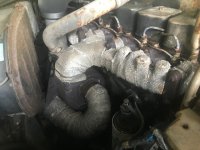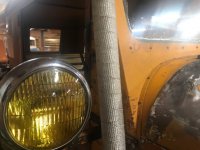1BG,
To expound a little bit on transmissions, some people think about the engines that the manufacturer has paired them with. For example Chevrolet put the Turbo 400 behind big-block engines for decades, or Chrysler put the 727 behind Hemis... so either should be more than sufficient in a snowcat....
But the typical automotive duty cycle is completely different than that of a snowcat. In an automotive application, the transmission is used to multiply the engines torques as it accelerates and shifts through the gears. Once up to speed, it really isn't subjected to all that much torque unless one climbs a long hill, and does so with a heavy load. Even in the Hemi example, in a drag race the transmission will shift from first to second and second to third...and that's it. Sure, it will be subjected to some serious shock loads and a lot of torque... for about 13 seconds at a time. But how much heat will the transmission build in 13 seconds? Now think about a school bus or a garbage truck. It weighs almost ten times that Barracuda or Charger/Challenger, and it is making frequent stops with accelerations between each; day after day after day. Almost always working...it's the difference between a thoroughbred and a pack mule.
In a rubber belted Tucker, the engine and transmission work hard almost continuously. For me, I think a transmission designed for medium duty trucks is more closely aligned with our needs than one designed for a station wagon or a muscle car. Back in the 1980s when Diesel engines were first introduced in pickup trucks, auto manufacturers paired those engines with one of their currently produced transmissions. And the result was a bunch of transmission warranty claims. Over the ensuing years, the Diesels have gained more power and the transmissions have gone through several evolutionary cycles of upgrades so they will hold up the rigors they're subjected to.
A turbo 400 transmission weighs about 135 pounds and a Chrysler 727 weighs about 160. Put them together and your right at what an AT545 weighs; about 289 pounds. I'm sure the difference in weight is not just the case, but rather beefier internal parts and clutches, etc.
But all that said, I'm not an automotive engineer. The above are the ramblings of a snowcat enthusiast, and Grade A knucklehead...
The Allison tranny...for sure is in a class all by itself.
As mentioned....the original diesels were tough on trannies.....
The TH400 and to a little bit lesser degree the TH350 can stand a beating IF THEY ARE BUILT RIGHT.
Shift kits (Transgo is my fav) are a must have to ensure longevity.
As mentioned...KEEPING THE OIL COOL is paramount...
The 727 TF is not a bad box....but in stock trim the shift timing was very poor.....(Seems Mopar engineers were more interested in making the big land yacht's operate smoooooooth and not shake grandma in the least)
The mushmellon shifts caused many premature clutch and and band failures....
I was working in a Mopar shop in the early 70's and the parade of big sleds with toasted trannies seemed way too common.
Shift calibration was the biggest issue.
The aftermarket companies came to the rescue and solved most of the ill's of the various gear boxes.
The TH400 has always been regarded as "Bomb proof" Well, somewhat would be my opinion. The 400 has been installed in some very large rigs over the years...and they have done well.....
Still...the big three auto makers never seem to include the tranny in their thinking when they added more power.....
Dodge came out with the 6.7 around 2006/2007 and the auto tranny was a joke.
If you were serious about working the big 6 cyl oil burner....you needed a tranny shop close by.
Later years have seen a lot of improvements......But the gear boxes always seem to be the last part of the equation to catch up.
The older Allison AT 545 IS A BEAST by any definition .....Firm shifting and made to deal with very demanding loads.....
The internal parts are very robust and there is really no standard pickup/car tranny that compares..
Then we can look at one of the worst gear boxes produced in recent history....The GM 700R4 (4L60 OR 4L60E)
There area always service bulletins that come out on just about every design....A book/binder with a modest amount of pages was is common...The 700R /4l60 THE LAST TIME I BOTHERED TO COUNT....HAD service bulletins that filled a shelf about 8 feet long in the office......
Design errors and corporate bean counters contributed to most of these.
The current crop of stuff from the manufs are outside my wheel house as I have not followed the trannies since the addition of the 6 through 10 speed models.
The old stand by boxes for sure can be upgraded to handle some pretty tough jobs.....Just always look at keeping the oil temp in check...
Another point
Just because you have a particular model of gear box does not always mean much....What engine was bolted up front of it ??? This will often spell out what clutch packs are/were used as well as a host of other differences in the inner workings.
4 pinion planets or 5...A heavier duty application most likely will have more robust parts.
Number of clutch friction plates......Lighter duty can/will have less friction plates in the clutch packs.....
Some light duty components were made of aluminum instead of steel....
The aftermarket has provided a wide variety of goodies to make your tranny better....
Heavy duty planet carriers
More robust sun shells
Better friction plates as well as better steel plates (Go between the frictions) and more of them.
Better bands with stronger anchors and better friction materials.
Higher output oil pumps.
Better bushings and thrust bearings.
In some cases....stronger input/output shafts.
Various little gizmos to stop case wear on some models..
An entire industry sprang up to deliver shift kits to fix various issues of internal oil leaks, shift timing, oil volume to the servos and on it goes.
You want an entirely manual (Select shift) No worries....it's available.
Governor calibration
Throttle pressure fixes
Vacuum modulator modification...
Complete valve bodies...yup, these too.
Torque converters of all sizes and stall speeds
Welded turbine and pump blades .....
If the box has a lockup converter.....Better lockup clutches and in some multiple disc clutches.
The original lockup clutch was simply a device to help get the "CAFE" Numbers up by eliminating the slipping in the converter at cruise speeds...... (Corporate average fuel economy)
THESE CLUTCHES ONLY OPERATED AT LIGHT TORQUE CRUISING SPEEDS....and could not hold heavy torque loads....and were released when the throttle was increased much....
The later boxes have multiple disc lockup clutches and in many cases are engaged at various times and shift points...especially with the diesels...
Beefier is better if you are going to get rough on things...or push things.
You can't have too tough of a tranny. Build the damned thing stout and set it on KILL.....Build it as strong as you can....If there are parts to make it twice as strong as you need...GET THEM....This stuff is pennys compared to what it costs to get your cat dragged out of brush 20 miles in..
More clutches do not hurt anything....just cost the OEM more $$$ and if the engineers say 3 clutch plates in 3rd gear is fine...they do it.
5 clutches are far better and will last a lot longer......
A needle bearing thrust assembly....far better than a plastic thrust washer, or even a steel backed bronze washer.
This subject can go on for pages and pages......but the bottom line.....IF YOU VAN GET A BIG HERKY BOX IN YOUR CAT....DO IT
The only real downside to the big Allison is parasitic drag.....Not worth worrying about in a rig that goes 12-15 mph
But the herky parts inside can give piece of mind to the owner while out in the back country....






